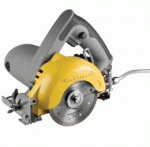Installing ceramic or porcelain tile should not be an intimidating project and with the right tools you can get professional results. My first tile installations were many years ago and there was no internet and I didn’t have tile saws or lasers, but I was able to work around those issues. What I wasn’t able to overcome was my lack of knowledge. For many years at our first cabin on the lake, the area in front of the fireplace was left as a concrete slab. In my mind I had pictured romantic evenings in front of the fireplace, but that slab did not lend itself to the mental image I had. So in a moment of industrious adolescence, I set out to dress up the area by installing ceramic tile. I purchased the tile and some plywood. I bought mortar mix and a trowel, a glass cutter and some dollar store nippers. When you are young you just don’t know how ignorant you really are. I will spare you the details of the tile cutting fiasco, but eventually I got the tiles cut and the plywood mortared to the existing slab. I installed the tiles onto the plywood base using mortar and spaced the tiles using a nail. I grouted and I cleaned grout from the tiles, the adjoining brick, and the carpet. After I finished, I stood back and I thought wow, I should do this to make extra money. It looked awesome. Flash forward a few years and I noticed grout separation and soon tiles began to crack and separate. Had I known about backing material and what thin-set was my tile job would still be intact today. Had I used a square and a tile saw, the installation would have been so much easier and faster.

You will need a level of some type to keep your tiles level when installing floor tiles. I use a 48″ level on flooring tiles. On one tile job I used the little hockey puck level and it worked fine, but the 48″ level you may already have and works better for me. It is just a matter of preference. On wall tile, you can use a bubble level, string level or a laser to mark your tile layout. The cheapest level for wall tile is the string level, consisting of string with a bubble level that attaches to the string. You stretch the string with the bubble attached to your horizontal layout line and mark it along the length of your string. I watched some tradesmen last week use this procedure. However, once the line was drawn they attached a straight piece of lumber for the bottom row of tile to rest on during installation. This straight edge not only served as means of keeping the first row of tile level, it also supported the tile while the thinset cured. What a great way to keep from dealing with tiles slipping on a vertical surface. Once the first row is installed, the lower tiles support the upper tiles. Using spacers kept everything in line while the mortar dried. Thanks to Kevin Talley of Talley Tile for showing me that tip. Lasers are the newest devices in levels. Actually lasers have been used for many years, but the entry cost has come down to the point where many homeowners are buying them. I use a Bosch Flooring and Tile Laser and for many years I have used a CST Berger laser for all of my layout work. These lasers throw out perpendicular lines, one for vertical and one for horizontal and the Bosch even throws out 45 degree lines.
You will need a chalk line for tile jobs of any size. Chalk lines are cheap, but they are priceless when laying out tile. For flooring tile use the chalk line to create your mid-point lines. You can use the chalk lines to lay out your individual rows of tile also.
Spacers come in various configurations and sizes. I am using the hard plastic ones now and I like them. I have used the rubber spacers and they also worked. On flooring I remove the spacers after about an hour so I can clean the grout lines. I keep a bucket of water nearby to drop the spacers in after removing them to keep the thin set from drying on them. Spacers are cheap, but you will find yourself using a lot of them. One bag of 100 is enough for most jobs.

Sliding tile saws versus the old school, Score and Break Tile Cutters. If you are buying, you can opt for the inexpensive tile cutters or as I mentioned in the first paragraph the inexpensive wet saw is a better option. You will have less breakage issues. If you live where its cold and are working with tile in the winter, you should choose the tile cutter. There is no water involved. Sliding tile saws come in sizes capable of cutting 24″ tiles and larger. I doubt many of you will ever install more than 20″x20″ tiles and this size is usually what is rented. I am using the Ridgid Tile Saw that belongs to Matt Weber, Editor-in-Chief. It is nice to have friends who you can borrow tools from and loan tools to. Just remember, if you borrow someone’s tools, return it in better and cleaner condition than when you received it. I loan my tools to very few people and the main reason is that my tools are important to me and if you borrow them and don’t treat them as I would, don’t expect me to loan more tools to you.




